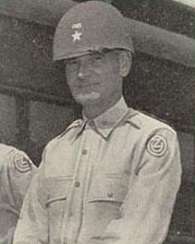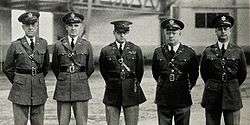Alonzo Patrick Fox
Alonzo Patrick Fox (November 11, 1895 – December 19, 1984) was a lieutenant general in the United States Army. He was prominent in the 1950s as a military advisor to the Assistant Secretary of Defense for International Security Affairs and as Deputy Assistant Secretary of Defense for National Security Council Affairs following his retirement from the Army. General Fox was also the father-in-law of Alexander Haig.
Alonzo Patrick Fox | |
|---|---|
 Brigadier General Fox as assistant division commander of the 102nd Infantry Division during WW II | |
| Born | November 11, 1895 Saint Louis, Missouri |
| Died | December 19, 1984 (aged 89) Washington, D.C. |
| Buried | |
| Allegiance | |
| Service/ | |
| Years of service | 1917–1957 |
| Rank | |
| Commands held | War Department Personnel Center, Fort Sam Houston, Texas |
| Battles/wars | World War II Korean War |
| Awards | Distinguished Service Medal Silver Star Legion of Merit Bronze Star |
| Other work | Deputy Assistant Secretary of Defense for National Security Council Affairs |
Early life
"Pat" Fox was born on November 11, 1895, in St. Louis, Missouri. He graduated from St. Louis University in 1917.
Military career
World War I
He was commissioned as a second lieutenant of infantry. During World War I, he was stationed at Camp Funston, Kansas.[1][2][3]
Interwar years

In 1921 Fox graduated from the Infantry School Basic Course.[4] Fox served in the Philippines from 1923 to 1924 and Hawaii from 1932 to 1935.[5] In 1932, Fox graduated from the Infantry School Advanced Course.[6] In the mid-1930s Fox served as an assistant professor of military science for the Reserve Officer Training Corps program at the University of Maine at Orono.[7][8][9] Fox graduated from the Army Command and General Staff College in 1938.[10][11] From 1938 to 1942, Fox served as an instructor at the Fort Benning Infantry School.[12]
World War II
When the U.S. entered World War II, Fox was promoted to brigadier general and in 1943 became assistant division commander of the 102nd Infantry Division, serving with the division through campaigns in northern France, the Rhineland and Central Europe.[13][14][15]
Post-World War II
From 1945 to 1946, Fox served as commander of the War Department Personnel Center at Fort Sam Houston, Texas, where he was responsible for the demobilization and discharge of soldiers returning from World War II.[16]
In 1946, General Fox was appointed as a deputy chief of staff of the Supreme Command Allied Powers in Japan.[17][18][19][20]
Korean War
When the United Nations Command was formed during the Korean War, Fox was named one of its deputy chiefs of staff. Fox participated in the Inchon landing in September 1950 and received the Silver Star.[21][22][23][24]
Post Korean War
The following year, General Fox was named the Army's member of the Joint Strategic Survey Committee, a senior advisory group of the Joint Chiefs of Staff.[25][26] From 1954 to 1955, Fox served as chief of staff for Allied Forces in Southern Europe.[27] Fox served as military adviser to the Assistant Secretary of Defense for International Security Affairs from 1955 to 1957.[28][29][30]
General Fox retired from the Army in 1957.
Awards
His decorations included multiple awards of the Distinguished Service Medal, the Silver Star, the Legion of Merit, and three Bronze Stars.[31][32]
Post-military work
From 1957 to 1959, Fox served as Deputy Assistant Secretary of Defense for National Security Council Affairs.[33][34][35]
In retirement, Fox resided in McLean, Virginia.
Death and burial
He died at Sibley Memorial Hospital in Washington, D.C., on December 19, 1984.[36] He was buried at Arlington National Cemetery, Section 2, Site 4735-G RH.[37]
Personal life
Fox was married to Elizabeth Jordan (October 7, 1900 – February 20, 1964). Their children included a son, Army Colonel Eugene A. Fox, and a daughter, Patricia Fox. Patricia Fox was the wife of Alexander M. Haig Jr.[38][39]
References
- The American Catholic Who's Who, Volume 14 (1960-1961), by Walter Romig, Grosse Point, Michigan, 1960, page 156
- World War I Draft Registration Card, Alonso P. Fox
- 1920 U.S. Federal Census Entry for Alonzo P. Fox
- U.S. Army Directory, published by U.S. Army Adjutant General, 1922, page 994
- The American Catholic Who's Who, Volume 14 (1960-1961), by Walter Romig, Grosse Point, Michigan, 1960, page 156
- U.S. Army Register, published by U.S. Army Adjutant General, 1949, page 181
- U.S. Army Directory, published by U.S. Army Adjutant General, 1935, page 230
- U.S. Army Directory, published by U.S. Army Adjutant General, 1936, page 229
- Yearbook, University of Maine Archived 2010-06-22 at the Wayback Machine, published by the University, 1937, page 30
- U.S. Army register, published by U.S. Army Adjutant General, 1937, page 232
- U.S. Army Register, published by U.S. Army Adjutant General, 1956, page 282
- U.S. Army Directory, published by U.S. Army Adjutant General, 1939, page 246
- World War II Order of Battle, 102nd Infantry Division, United States Army Center of Military History
- Newspaper article, 102nd Infantry Division Reunion in Chicago, The Hamburg (Iowa) Reporter, July 9, 1953
- With the 102nd Infantry Division Through Germany, by Allan H. Mick, 1980, page 277
- Newspaper article, Unit of War Weary 36th Back in Texas, by Associated Press, published in the Port Arthur (Texas) News, June 22, 1945
- Hell or High Water: MacArthur's Landing at Inchon, by Walter J. Sheldon, 1968, page 95
- MacArthur's War: Korea and the Undoing of an American Hero, by Stanley Weintraub, 2001, page 357
- Remaking Japan: the American Occupation as New Deal, by Theodore Cohen and Herbert Passin,1987, page 134
- Newspaper article, Gen. Fox Named to MacArthur Staff, San Antonio Light, August 13, 1946
- Magazine Article, Danger Zones: Reconnaissance in Formosa, TIME Magazine, August 14, 1950
- Newspaper article, Silver Stars Awarded, by Associated press, published in the Palm Beach Post, October 16, 1950
- MacArthur's X Corps in Korea: Inchon to the Yalu, by Edward L. Daily, 1999, page 128
- America's Tenth Legion: X Corps in Korea, 1950, by Shelby L. Stanton, 1989, page 323
- Newspaper article, Formosa Raises its Hopes for Return to Mainland, New York Times, May 6, 1951
- Newspaper column, Washington Calling, by Marquis Childs, published by United Features Syndicate, Inc., published in Reading (Pennsylvania) Eagle, May 23, 1951
- Newspaper article, Staff Chief Named, Reading (Pennsylvania) Eagle, May 18, 1954
- Newspaper article, Legion is Urged to Push Air Study, New York Times, October 8, 1955
- Military Government Journal, published by the Military Government Association, 1956, Volume 8, page 21
- U.S. Army Register, published by U.S. Army Adjutant General, 1957, page 285
- Military Times, Hall of Heroes, Alphabetical Index Archived 2010-01-03 at the Wayback Machine, recipients of Major Military Awards
- U.S. Army Register, published by U.S. Army Adjutant General, 1956, page 282
- U.S. Army Directory, published by U.S. Army Adjutant General, 1958, page 121
- Hearing Record, National Commission on Urban Problems U.S. House Committee on Foreign Affairs, 1958, page 75
- United Nations Emergency Force: Hearings Before the U.S. House of Representatives Foreign Affairs Committee Subcommittee International Organizations and Movement, 1958, page 46
- Social Security Death Index
- National Gravesite Locator, U.S. Department of Veterans Affairs
- The American Catholic Who's Who, Volume 14 (1960-1961), by Walter Romig, Grosse Point, Michigan, 1960, page 156
- Newspaper article, Alexander M. Haig Jr. Dies at 85; Was Forceful Aide to 2 Presidents, by Tim Weiner, New York Times, February 20, 1010